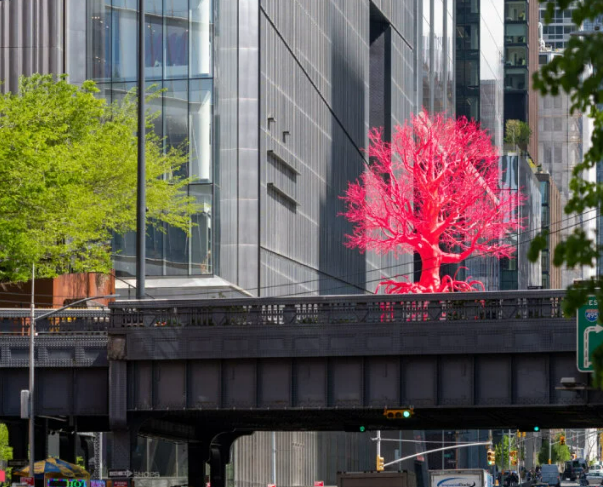Pamela Rosenkranz is a renowned Swiss artist known for her contemporary art practice, which focuses on the human need to attribute meaning to her works and humanize the surrounding environment in order to better understand it.
Through her artworks, she explores the codes and conventions through which people give meaning to the natural world. One distinctive element of Rosenkranz's works is the recurring use of synthetic materials that reference nature. One of her most famous works involved the insertion of a viscous fluid resembling water into a swimming pool, which simultaneously evoked the artificiality of the substance while referencing water. In another installation, collections of mineral water bottles filled with silicone were displayed. In this case, she aimed to represent a tension between the natural representation of water and the intervention of silicone, a synthetic substance. These material choices reflect her interest in the construction of our perceptions and meanings through the use of synthetic simulacra.
The sculpture "Old Tree," commissioned for the High Line Plinth, is a significant example of Rosenkranz's work. The sculpture is made of artificial materials and features a combination of bright red and fluorescent pink colors. This chromatic choice recalls the branching systems of human organs, blood vessels, and tissues, suggesting a deep connection between human and plant life. The tree, a symbol of ancient wisdom and human evolution, becomes a meeting point between the sky and the earth. The installation of "Old Tree" on the High Line, an urban park built on a site that was once occupied by industrial structures, raises questions about the concepts of "artificial" and "natural," which are closely tied to the artist's ideology. Despite being made with synthetic materials, the sculpture blends into the park's natural context and provides a social space for viewers who, in turn, learn to appreciate this type of art. Its imposing height of 25 feet and branching shape also create shade and project a changing luminous aura that absorbs the natural lights of different times of the day. Through the artwork "Old Tree," Rosenkranz also addresses the theme of the relationship between humanity and the natural world. She investigates our incessant desire to control and manipulate both the living beings around us and our own bodies. The artwork invites viewers to reflect on the concept of "nature" and our perception of what is authentic or artificial.

In conclusion, Pamela Rosenkranz's works focus on the anthropomorphization of the environment and the conventions through which we attribute meaning to the natural world. By using synthetic materials that reference nature and evoking historical archetypes such as the tree of life, the artist stimulates critical reflection on our understanding of what is "artificial" or "natural" in contemporary society.
The garden of New York City
The High Line is a disused railway line that cuts through the city two different paths, providing a sense of elevation and offering a unique perspective of the surrounding panorama. Looking upward, one cannot help but notice the contrast between the relatively untamed vegetation and the imposing buildings that the lines of the railway provides. The transition is striking, from the magnificent metropolitan architecture to the advertising billboards, and then abruptly of the urban decay, creating a breathtaking spectacle.
Focusing on the plant life that thrives on the High Line, one can quickly realize that two distinct plant communities coexist: an open meadow environment and a mini forest. The open meadow is adorned with numerous ornamental grasses and perennial plants, which during late summer and autumn provide a unique sensation reminiscent of the wild vegetation found outside New York City. The second community feels more enclosed as the surrounding architecture casts shadows on the garden. Here, small trees such as birches, dogwoods, and other similarly-sized trees dominate. The vegetation in this urban corner resembles a true forest, with the pathway occasionally narrowing or splitting into multiple levels. This architectural design allows visitors to choose the path that best suits their perspective of the city, offering an opportunity to appreciate the intricate patterns formed by the plants growing in this artificial woodland.
Online EditorialStaff




 This site uses anonymous technical cookies to ensure navigation and third-party cookies to monitor traffic and to offer additional services such as viewing videos or messaging systems. Without third-party cookies some pages may not work properly. Third-party cookies can track your activity and will only be installed by clicking on the "Accept all cookies" button. You can change your selection at any time by clicking on the "Cookie" link on each page at the bottom left. By clicking on one of the two buttons you declare that you have read the privacy policy and to accept the conditions.
This site uses anonymous technical cookies to ensure navigation and third-party cookies to monitor traffic and to offer additional services such as viewing videos or messaging systems. Without third-party cookies some pages may not work properly. Third-party cookies can track your activity and will only be installed by clicking on the "Accept all cookies" button. You can change your selection at any time by clicking on the "Cookie" link on each page at the bottom left. By clicking on one of the two buttons you declare that you have read the privacy policy and to accept the conditions.